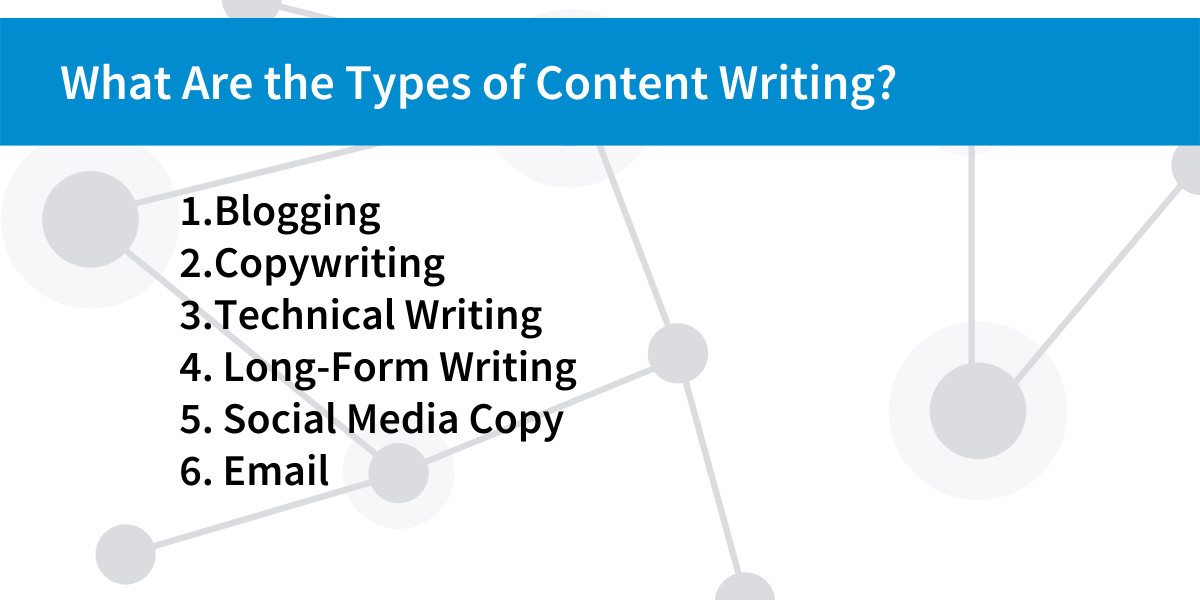
Today, content writing practices are used in the creation of various forms of content, including:
Blogging: Blogs are a central part of building a strong content strategy, they can convey ideas related to products and your brand, while highlighting your thought leadership. Blogs can also be useful for SEO purposes, building organic traffic, and raising brand awareness.
Email: Writing content for emails can help convert customers and generate better engagement for your business. Email marketing also helps to build loyalty and strengthen your opportunities for repeat purchases.
Social media: Social channels require content writers to communicate various ideas and campaigns as effectively as possible.
Product content: Selling products and services requires a unique set of writing skills. You’ll have to balance sales copy with storytelling and SEO strategies.
Brand journalism: PR news releases, customer and brand stories, and internal communications can all require the support and guidance of a content writer.
Whitepapers and eBooks: Content writers can help to produce highly technical and professional content which requires a focus on a specific subject. This helps to strengthen the authority of the brand.
Video scripts: If scripts are required to create videos or even podcasts for a company’s branding purposes, a content writer can assist with this.
Concept Details
Types of Content Writing
Content writing is about more than focusing on packing blogs full of SEO keywords or bland email marketing. Writing should be engaging and informative while being unique to your brand’s voice. So what does content writing include? While content writing can span many different genres, there are a few broad categories and types of writing that you will most likely encounter. When embarking on a content writing journey you could consider: blogging, copywriting, technical writing, social media posts, and emails.
Blogging
Creating blog posts is a staple of content writing. Blog posts help to boost your website’s SEO rankings since search engines reward websites that are constantly putting out new content. You’ll want to identify different high-ranking keywords to include in your posts so that when people search for them, your blog pops up first. That requires some research to understand the language your ideal customers use when searching for answers to their questions. But it’s important not to keyword stuff. Depending on the length of your content, you’ll want approximately one keyword per 100-150 words (so a 750-word blog should have between 5-8 keywords). DemandJump can help you determine the highest-ranking keywords based on what customers are searching for online. This takes out painstaking research and gives you high-value keywords quickly. Blogging can cover a wide range of topics and have a variety of writing styles, depending on the topic and brand goals. Typically your blog posts will be more conversational and approachable—the key is to educate, inform, and entertain!
Copywriting
Copywriting is the core of building a website and advertisement copy. Without copywriting, your informative content could be bland and not persuasive. The goal of copywriting is to sell your product to current and prospective customers. This type of content writing includes things like writing your:
- Website copy
- Product descriptions
- Sales collateral
- Advertisements
- Press releases
- Print ads
- Infographics.
This is the nuts-and-bolts type of content writing that people don’t often think about or spend a lot of time on. However, this is an important piece of the content marketing puzzle! You should craft these messages strategically while understanding that these types of written pieces are the foundation of your brand…and often the first thing that your potential customers will read.
Technical Writing/Long Form
Technical writing can seem intimidating, but as someone who understands your own business and products, this can sometimes be the easiest type of content to produce. From creating white papers to ebooks to how-tos, this is your chance to explain how your product or service works, how your customer can apply it, and educate your audience on the specifics. Keep in mind that you still want this to be approachable—try not to use too much jargon or explain it if you need to use it.
